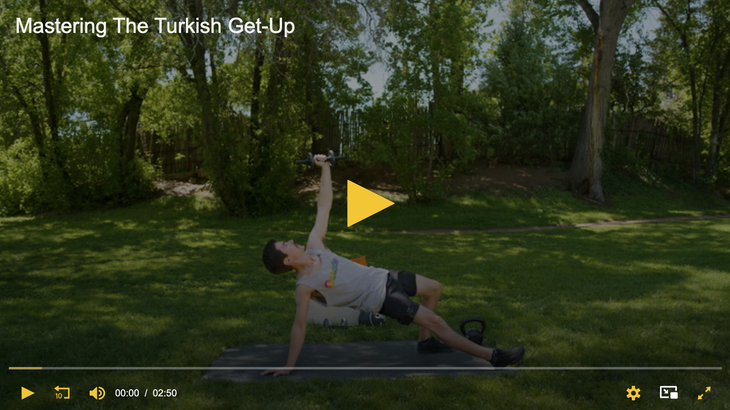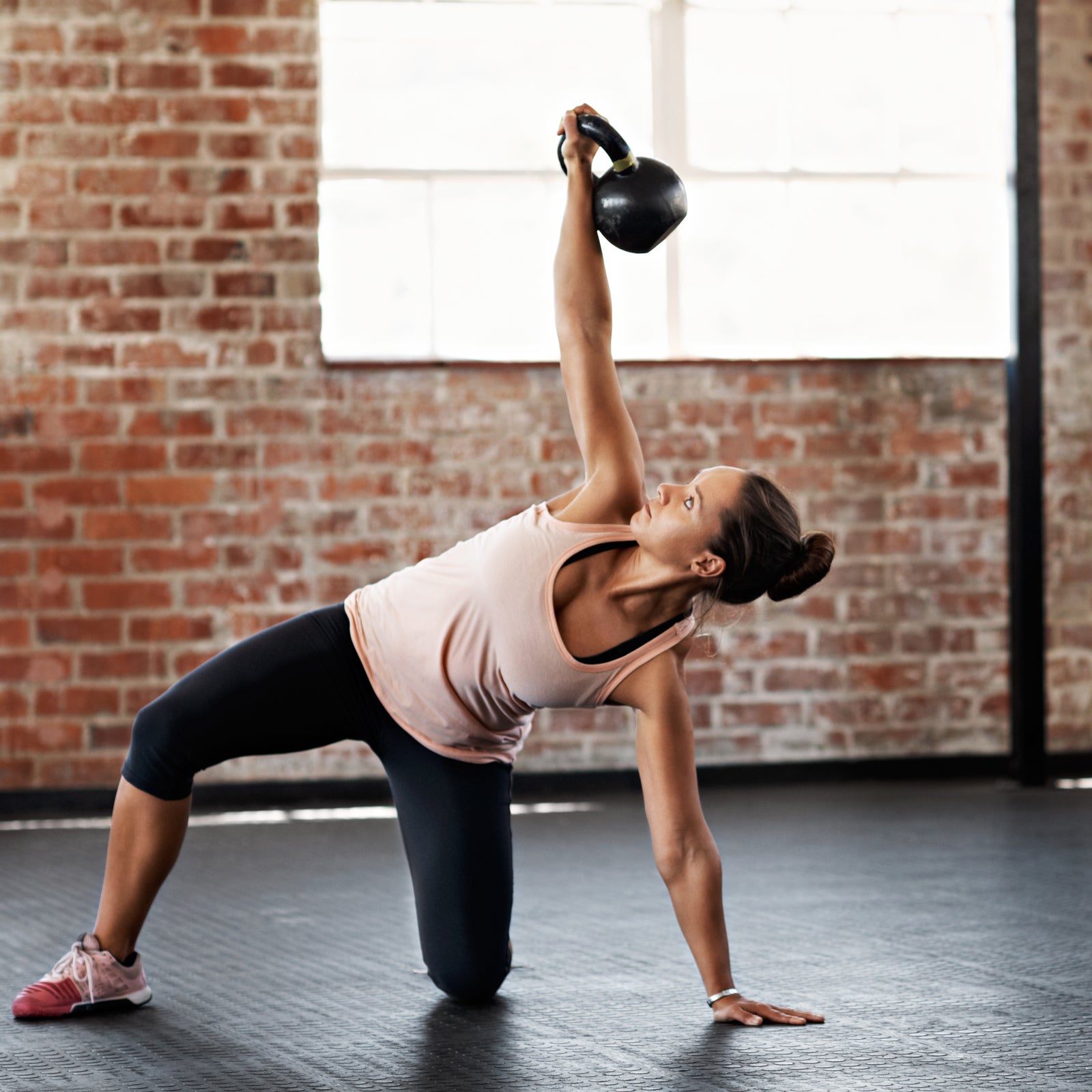If you only chose to do one exercise for the rest of your life, you’d be well served to make it the Turkish get-up (TGU). “Everyone can benefit from this movement,” says Rafique “Flex” Cabral, a National Academy of Sports Medicine–certified personal trainer and cofounder of�� in New York City.
The complex, full-body exercise��emphasizes balance, coordination, core strength and stability, and overall body tension, Cabral explains. “For outdoor athletes, that stability is a huge piece,” he says. “It will help you generate more power through your core and create a firm, solid base throughout your trunk to transition forces between your lower and upper body.” While skiing on the mountain, this strength will help you��maintain a quiet upper body while your legs carve turns at high speed, and it’ll keep you��balanced and holding your momentum while running through steep, technical terrain.
Along with working your entire core, the Turkish get-up��targets nearly every major muscle group, as well as smaller stabilizers, starting with the shoulders, says Cabral. “The get-up is great for shoulder mobility, stability, and strength—all of which will help��protect the joints from injury—since you’re holding a weight in a constant overhead position,” he says. The multistep movement essentially blends a chest and overhead press, hip hinge, and lunge, all in one: it’s a true full-body challenge.
Because the complexity of it��can be intimidating at first, Cabral breaks it down into manageable steps. “Everybody has the ability to do it,” he says. “The TGU just takes practice.”
How to Do a Perfect Turkish Get-Up

Kettlebells are��the go-to weights for Turkish get-ups, but you can also use a dumbbell or a household object, such as a jug of water or even a pair of skis.
Step 1: Lie on your left side in a fetal position, with the kettlebell on the ground in front of your chest. Grasp the handle with an underhand grip in your left hand. If the weight is heavy for you, hold it with both hands, using an overhand grip with the right.
Step 2: Roll onto your back, with the kettlebell at your side. Bend your left knee to approximately 70 degrees, place your left foot flat on the floor, and extend your right leg at a 45-degree angle from your body.
Step 3: Press the kettlebell straight up and��directly over your chest, until your elbow(s)��are fully extended. If the weight is on the lighter side, and you can lift it in control, you can use your left arm only. Then drop your right arm to the floor, and extend it at 45-degree angle from your body, placing��your palm down for support. This is the starting position, which you’ll return to each repetition. From this moment on, keep your eyes on the kettlebell, and hold it straight overhead, in control.
When you become proficient at the movement, you can do steps two and three simultaneously, but start with them as distinct stages.
Step 4: Keeping your eyes on the kettlebell, roll up��onto your right elbow. There should be a straight, vertical line from the��kettlebell down through your shoulders to your grounded elbow.
Step 5: Straighten your grounded arm to prop yourself up into a seated position. Slide your hand closer to your body��if needed.
Step 6: Thrust your hips off the ground until the thigh of your bent leg and your torso form a straight line.
Step 7: Sweep your right leg back into a kneeling position underneath your hips. Come up off your grounded hand, and bring your torso to an upright position.
Step 8: Then��pivot your back foot to enter a��lunge, with your knee still on the ground.
Step 9: Finally, stand up and bring your feet together.
Step 10: Reverse the movements in order, still keeping your eyes on the bell.
Common Mistakes
The Turkish get-up is all too easy to flub. Poor form means you’ll miss out on the full benefits of the exercise,��and you could increase your chance of injury.��According to Cabral, these are the pitfalls��to look out for.��
Rushing through the movement:��This isn’t an exercise you can bang out quickly, especially if you’re new to it. Moving too fast will inhibit your ability to maintain proper mechanics. Instead, take it slow, and work through the exercise step by step. Pause between stages to hone in on proper body��positioning before moving forward.
Wandering eyes:��“If you don’t keep your eyes on the bell, your��positioning could be off and you wouldn’t know it,” says Cabral. “You need to have full awareness of where the load is overhead as you’re working through the movement.” From start to finish, keep your gaze��locked on the kettlebell.
A bent or off-center arm:��If the arm holding the kettlebell is not fully extended at the wrist and��the elbow joints, or if your shoulder is skewed to the side, muscles like the wrist flexors, triceps, and shoulders will be forced to work overtime. This is inefficient and can lead to��injury. Keep your raised arm completely straight and vertical through the wrist and the elbow, with the load stacked directly over the supporting arm and shoulder. Both of your shoulders should be engaged.��
A lack of body tension:��This often goes hand in hand with moving too quickly. “When I see people rushing through the TGU and they’re wobbly or unstable, that usually means they’re not creating enough tension across the body to be able to stabilize the movement,” says Cabral. Once again, slow it down. Keep everything—your hamstrings and glutes,��core, and shoulders—engaged. If��your form begins to break,��stop the exercise. Pick a lighter kettlebell, rest for a few minutes,��or call it a day. There’s no use pounding through junk sets.
Lifting too heavy, too fast:��If you’re unfamiliar with the movement, grabbing the same weight as your friend or a random person you see in the gym is an easy way to get hurt. Before you add load to the exercise, hold your upper hand in a fist and start with a shoe balanced on top of your knuckles.��It’s much harder than it seems. “If you’re able to keep the shoe balanced��throughout the movement, you’re going to be able to balance a weight much better,” Cabral says. Even if you’ve been doing the Turkish get-up for years, the shoe exercise is a worthwhile way to check on your form.��
Incorporating��the Turkish Get-Up into Your Training
There’s no limit to the ways in which you can use this movement, but how you do it will differ based on your current fitness and personal goals.
Warm-up:��If you plan on doing a��full-body strength workout or loaded leg exercises��such as squats, deadlifts, or Olympic-style lifts, the Turkish get-up makes an excellent warm-up. Use a lightweight kettlebell (five to ten��pounds is a good starting point) or body weight only, and perform one to two sets of ten��reps per side. Complete all reps on one side before switching to the other, with no rest between sides.
Cardio:��Aim for three sets of eight to twelve��reps, and either alternate legs each rep (for��more of a cardio challenge) or complete all reps on one side before the other, with no rest between sides (for��more of a strength challenge). Move at a moderate to quick pace��while maintaining good form, and focus on efficiency of movement, especially in the transitions between body positions and reps.
Strength:��Use a heavier weight than you would for a circuit, and aim for four to six sets of four to six reps. Complete all reps on one side before switching to the other, ideally with no rest between sides. Rest for two to three minutes between sets, or rotate to another exercise that challenges��different muscle groups.
Stand-alone workout:��If you’re short on time or��equipment, the Turkish get-up makes an effective workout on its own. Start with a lightweight or a body-weight set to warm up, then pump up the intensity based on your desired training effect. Moderate weight and higher reps offer��good��conditioning, while a heavier��weight and lower reps build��strength. Another approach is to progressively add resistance each set.��You can also cycle through a few sets��after a run or a climbing session to top off the day, Cabral says.


